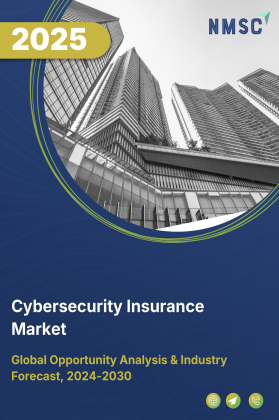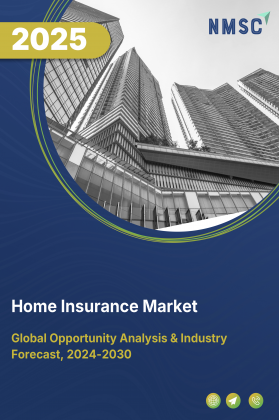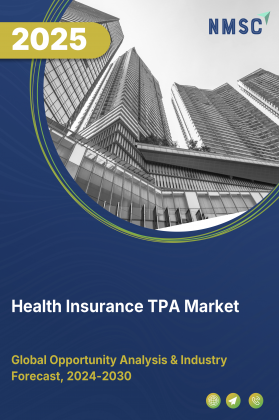
Cybersecurity Insurance Market By Component (Solution and Services), By Coverage Type (First‑Party, Third‑Party, and Hybrid), By Insurance Type (Standalone Policies, Packaged/Endorsed), By Provider Type (Insurance Providers, and Technology Providers), By Organization Size (Large enterprise, Small & Medium Enterprises), By Deployment Mode (Cloud-Based and On-Premises), and By End-User (IT & telecom, Banking, and Others) – Global Opportunity Analysis and Industry Forecast 2024-2030
Industry Overview
The global Cybersecurity Insurance Market size is estimated at USD 21.37 billion in 2024 and is expected to be valued at USD 25.69 billion by the end of 2025. The industry is projected to grow, reaching USD 64.49 billion by 2030, with a CAGR of 20.21% between 2025 and 2030.
The market is rapidly evolving as organizations face an increasing wave of complex and damaging cyberattacks. As threats grow more sophisticated, businesses are turning to cyber insurance to protect against financial losses, legal liabilities, and reputational harm. The rise in digital activity particularly from e-commerce alongside stricter data privacy regulations, has further intensified demand for coverage.
At the same time, insurers are grappling with limited underwriting capacity and rising reinsurance costs, leading to tighter terms and higher premiums. Despite these challenges, the market is seeing new growth opportunities, especially in addressing emerging risks tied to artificial intelligence. Insurers offering tailored solutions for AI-related threats are well-positioned to gain a competitive edge in this dynamic landscape.
Escalating Frequency and Sophistication of Cyberattacks are Driving Increased Market Demand
Insurers are seeing unprecedented volumes of cyber events, with a report stating that 1,641 incidents among its US and Canadian clients through October 2024, 11 % of which involved extortion and ransomware demands. As attackers employ more sophisticated tools and tactics, organizations increasingly seek financial protection against first and third party liabilities, business interruption and reputational harm. This surge in claims activity has lifted global premiums, with Swiss Re forecasting market growth to USD 16.6 billion in 2025, a rise of 8 % year over year underscoring insurers’ ability to price new risk layers into their products.
Global E-Commerce Growth is Boosting Market Expansion for Cyber Insurance
The growth of e-commerce leads to an increase in online transactions and the collection of sensitive customer data. This surge in digital activity heightens the risk of cyber threats, such as data breaches and payment fraud. As a result, e-commerce businesses become more aware of the financial risks associated with cyber incidents, driving them to seek cybersecurity insurance for protection.
According to the International Trade Administration 2024, the global B2C e-commerce revenue is expected to grow at USD 5.5 trillion by 2027 as compared to 2023 with a revenue of USD 3.6 trillion marking a growth of 53%. This increased demand for insurance contributes to the growth of the market.
Tightening Regulatory and Data Privacy Compliance Requirements are Prompting Organizations to Purchase Cyber Insurance
Tightening regulatory and data privacy mandates are driving organizations to secure cyber insurance as a cornerstone of their compliance strategies. In the U.S., the HHS Office for Civil Rights levied USD 143.98 million in HIPAA civil money penalties across 148 enforcement actions as of October 31, 2024, targeting failures to protect electronic patient records.
Meanwhile, 78% of private sector leaders report that evolving cyber privacy regulations effectively reduce organizational risk, highlighting why compliance imperatives now rank among the top motivations for purchasing cyber insurance, according to WEF Global Cybersecurity Outlook 2025. By transferring potential fines and legal costs to insurers, companies both mitigate exposures and demonstrate proactive governance to regulators and stakeholders.
Limited Underwriting Capacity Combined with Rising Reinsurance Costs is Constraining the Market Growth
Despite growing demand, insurers face capacity bottlenecks as reinsurers tighten terms to manage aggregating exposures. It has been observed surging reinsurance rates, driven by the frequency and severity of losses, which in turn pressures primary insurers’ profitability and leads to stricter underwriting criteria. This constrains available limits for large scale risks and can drive up premiums or reduce coverage breadth for customers with less mature cybersecurity postures, limiting market growth if not addressed.
Rising Demand for AI-Specific Cyber Insurance Presents a Key Growth Opportunity
Rising demand for AI specific cyber insurance presents a key growth opportunity amid evolving technologies and regulations. According to McKinsey’s State of AI Global Survey (March 2025), 78 % of organizations deploy AI in at least one business function up from 72 % in early 2024 and 55 % in early 2023.
Simultaneously, the Council of Europe’s Framework Convention on Artificial Intelligence, adopted in May 2024, has been endorsed by over many countries, signaling intensifying regulatory scrutiny. These developments expose organizations to novel liabilities model manipulation, data poisoning, and non compliance with nascent AI governance frameworks, that fall outside traditional cyber policies.
Insurers that introduce tailored endorsements for AI specific exposures can bridge this protection gap, differentiate their offerings with real time risk monitoring and compliance advisory, and secure market share in a rapidly expanding niche.
Market Segmentation and Scope of Study
The cybersecurity insurance market report is divided on the basis of component, coverage type, insurance type, provider type, organization size, deployment mode, distribution channel, and end-user, and region. On the basis of components, the market is categorized into solutions and services. On the basis of coverage type, the market is divided into first‑party coverages, third‑party coverages and hybrid. On the basis of insurance type, the market is segmented into standalone and packaged. On the basis of provider type, the market is grouped into insurance provider and technology providers. On the basis of organization size, the market is divided into large enterprise, small & medium enterprises. On the basis of end-user, the market is categorised into IT & telecom, healthcare, manufacturing, and others. Regional breakdown and analysis of each of the aforesaid segments includes regions comprising of Asia-Pacific, North America, Europe, and RoW.
Geographical Analysis
North America dominates the cybersecurity insurance market share at present and is projected to continue its dominance throughout the forecast period. This is attributed to the expansion of e-commerce that increases online transactions and the collection of sensitive customer data. This rise in digital activity elevates the risk of cyber threats, including data breaches and payment fraud during online shopping’s and transactions.
According to the Mexican Association of Online Sales, Mexico’s domestic e commerce market reached USD 39.3 billion in 2024, marking over 20 % growth from 2023. Consequently, businesses turn to cybersecurity insurance for protection further fueling the growth of the market.
Similarly, Europe commands roughly one fifth of global cyber insurance premiums and is poised for steady growth. In June 2025, Marsh introduced a dedicated cyber insurance facility for mid sized European enterprises, addressing the intensifying threat landscape and underwriting gaps in markets such as France and Spain.
Also, Resilience, a leading cyber risk solutions firm, expanded its European operations to Germany and Austria in May 2025, hiring regional leadership and partnering with local brokers to drive policy uptake across core EU markets.
On the other hand, Asia-Pacific is projected to experience steady growth in the cybersecurity insurance market demand, driven by the increasing number of internet users, that expands online activities such as social networking and data sharing. This rise in digital engagement heightens the need for robust cybersecurity measures, leading to greater demand for insurance coverage to protect against potential cyber threats.
According to the report published by the International Association of Accounting Professionals 2024, nearly 1.1 billion people in China are internet users, reflecting an internet penetration rate of 78% as of June 2024. This marks an increase of 7.42 million users since December 2023. As a result, businesses and individuals seek cybersecurity insurance to safeguard against potential financial losses from cyber risks, that is further driving market growth.
Moreover, the rising healthcare expenditure results in greater investment in digital technologies and electronic health records (EHRs). This increased investment amplifies the volume of sensitive patient data stored online, which elevates the risk of cyber threats such as data breaches and ransomware attacks.
According to the World Bank Group 2024, Japan's healthcare expenditure per capita reached USD 4,676 in 2021, representing a 23.3% increase from USD 3,793 in 2011. As a result, healthcare organizations seek cybersecurity insurance to protect against financial losses from cyber risks, driving the cybersecurity insurance market growth.
The Rest of World (RoW) holds smaller share of the cyber insurance sector, which largely reflects lower levels of digital adoption and regulatory maturity. For instance, in Sub Saharan Africa, only 38% of residents were online in 2024, compared with over 90 % in high income economies, further constraining the industry size.
Additionally, many RoW countries have only recently begun enacting comprehensive data protection laws, dampening regulatory drivers for coverage. As internet use and e commerce expand and governments strengthen privacy regulations, these markets are poised for stronger cyber insurance growth in the coming years.
Strategic Analysis Adopted by Key Players
In 2025, the cybersecurity insurance industry saw a strong push toward innovation, regional diversification, and tailored risk solutions. Key trends included AI-focused coverage, SME-friendly capacity facilities, integrated cyber-risk platforms, and sector-specific bundled policies.
Emphasis shifted toward proactive risk management, regulatory alignment, and global expansion to address evolving digital threats and compliance needs. These market players are opting for strategies such as product launches to maintain their dominance and competitiveness in the sector.
-
In July 2025, QBE North America launched AI focused cyber insurance solutions covering AI regulatory compliance and LLMjacking, helping clients manage fines, defense costs and retraining expenses tied to cloud hosted large language models. This builds on its 2023 QCyberProtect policy and underscores QBE’s commitment to keeping pace with rapid AI adoption. Meredith Brown, Head of U.S. Cyber & E&O, emphasized that these targeted coverages fill gaps in traditional cyber policies amid evolving AI regulations.
-
On June, 2025, Marsh launched Cyber Unity, a streamlined cyber insurance facility for European mid sized enterprises. Backed by six A rated insurers, it offers up to USD 5.86 million primary capacity, pre negotiated claims handling and incident response services. By reducing barriers for SMEs in markets like France and Spain, Marsh is positioning itself as the broker of choice for closing critical protection gaps.
-
In May 2025, Resilience announced the launch of its cyber risk platform in Germany and Austria, hiring local leadership and partnering with regional brokers to drive policy uptake. This marks Resilience’s seventh European market and demonstrates its strategy of combining tailored underwriting with integrated risk management services. The expansion enhances Resilience’s competitive positioning against established carriers and reinforces its commitment to delivering end to end cyber resilience solutions.
-
On April, 2025, Chubb unveiled Premier Life Science in Singapore, Australia, Hong Kong and Korea to mark 20 years of its APAC life sciences practice. The multi line policy bundles product liability, clinical trials insurance, professional indemnity and cyber coverage, addressing the sector’s complex digital and regulatory exposures. By simplifying access to combined casualty and cyber protections, Chubb is strengthening its brand visibility and long term growth in a high innovation industry vertical.
-
In October 2024, Coalition signed a multi year capacity agreement with Mitsui Sumitomo Insurance to underwrite its Active Cyber Insurance in Australia from January 1, 2025. This builds on their longstanding collaboration in Japan and brings dynamic risk prevention tools to over 1,400 Australian SMEs. The deal also included a USD 30 million equity investment from MS&AD in March 2025, anchoring Coalition’s global expansion and reinforcing its Active Insurance model.
Key Benefits
-
The report provides quantitative analysis and estimations of the market from 2025 to 2030, that assists in identifying the prevailing industry opportunities.
-
The study comprises a deep-dive analysis of the current and future cybersecurity insurance market trends to depict prevalent investment pockets in the sector.
-
Information related to key drivers, restraints, and opportunities and their impact on the market is provided in the report.
-
Competitive analysis of the players, along with their market share is provided in the report.
-
SWOT analysis and Porters Five Forces model is elaborated in the study.
-
Value chain analysis in the market study provides a clear picture of roles of stakeholders
Cybersecurity Insurance Market Key Segments
By Component
-
Solutions
-
Policies
-
Coverage plans
-
-
Services
-
Risk assessment
-
Cybersecurity consulting
-
Incident response
-
Breach notification
- Claims management
-
By Coverage Type
-
First‑Party Coverages
-
Third‑Party Coverages
-
Hybrid/Composite
By Insurance Type
-
Standalone Policies
-
Packaged/Endorsed
By Provider Type
-
Insurance Providers
-
Technology Providers
By Organization Size
-
Small & Medium Enterprises (SMEs)
-
Large enterprise
By Deployment Mode
-
Cloud-Based Cybersecurity Insurance
-
On-Premises Cybersecurity Solution
By Distribution Channel
-
Brokers & Agencies
-
Direct Sales (Insurer-to-client)
-
Online Platforms & Insurtech
-
Partnerships
By End-User
-
BFSI
-
Healthcare
-
IT & Telecom
-
Retail & E-commerce
-
Manufacturing
-
Government & Public Sector
-
Energy & Utilities
-
Others
By Region
-
North America
-
The U.S
-
Canada
-
Mexico
-
-
Europe
-
The UK
-
Germany
-
France
-
Italy
-
Spain
-
Denmark
-
Netherlands
-
Finland
-
Sweden
-
Norway
-
Russia
-
Rest of Europe
-
-
Asia-Pacific
-
China
-
Japan
-
India
-
South Korea
-
Australia
-
Indonesia
-
Singapore
-
Taiwan
-
Thailand
-
Rest of Asia-Pacific
-
-
Rest of the World
-
Latin America
-
Middle East
-
Africa
-
Key Players
-
Chubb Limited
-
Hylant Group Inc.
-
AttackIQ
-
American International Group Inc.
-
Aon plc.
-
Liberty Mutual Insurance Company
-
Lockton Companies
-
AmTrust Financial
-
At‑Bay
-
Arch Insurance (Arch CyPro)
-
Coalition, Inc.
-
Sompo International Holdings Ltd.
-
Tokio Marine HCC
Report Scope and Segmentation
|
Parameters |
Details |
|
Market Size in 2025 |
USD 25.69 Billion |
|
Revenue Forecast in 2030 |
USD 64.49 Billion |
|
Growth Rate |
CAGR of 20.21% from 2024 to 2030 |
|
Analysis Period |
2024–2030 |
|
Base Year Considered |
2024 |
|
Forecast Period |
2025–2030 |
|
Market Size Estimation |
Billion (USD) |
|
Growth Factors |
|
|
Countries Covered |
28 |
|
Companies Profiled |
15 |
|
Market Share |
Available for 10 companies |
|
Customization Scope |
Free customization (equivalent to up to 80 working hours of analysts) after purchase. Addition or alteration to country, regional, and segment scope. |
|
Pricing and Purchase Options |
Avail customized purchase options to meet your exact research needs. |

















 Speak to Our Analyst
Speak to Our Analyst

























